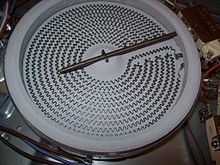Ceran

Ceran is a brand name of Schott AG (in Mainz ) for temperature change-resistant glass and goods made from it.
Material properties
Glass ceramics are traded under the brand name Ceran , which have high permeability for thermal radiation , low thermal conductivity and high thermal shock resistance due to their low coefficient of expansion . The most common goods are hobs .
Glass ceramic plates have a high permeability for thermal radiation (i.e., like glass, glass ceramic has a low attenuation constant for parts of the infrared spectrum) and practically no thermal expansion . They have a smooth, pore-free surface. The majority of the heat transfer in glass ceramic hobs therefore takes place through heat radiation instead of heat conduction (as with steel or iron hotplates). The thermal conductivity is very low at 1.46 W / (m · K), which means that the area next to the hotplate remains cold. Steel or iron hotplates, on the other hand, only use their high thermal conductivity for heat transport.
Glass ceramic is a semi-crystalline material that is created by incomplete crystallization ("ceramization") of suitable glasses. During production, areas with an ordered crystal structure are created in the glass matrix . With the appropriate chemical composition, this glass ceramic has a negative coefficient of thermal expansion , i.e. it contracts when heated. If the ratio of glass to crystal phase is set appropriately, a material is created that practically does not expand when heated. The main components of the glass ceramic for Ceran cooktops are lithium, aluminum and silicon oxide (so-called "LAS glass ceramic").
Such a glass ceramic can withstand sudden temperature shocks of up to 750 K undamaged.
development
Glass ceramics with the properties described above were developed by Schott AG in Mainz in cooperation with Imperial-Werke in Bünde . In 1971 the production of a small series and the presentation of the first prototype at the Domotechnica trade fair began , in 1973 series production began.
Applications
The most widespread use is the glass ceramic cooktop in connection with electrical radiant heating. Here, a heating resistor arranged below the glass ceramic is heated to red heat. The infrared heat radiation emitted by the heating element passes through the infrared-permeable glass ceramic and heats the bottom of the pot or pan. The cooking surface lets the heating energy reach the cooking vessel with almost no heat loss, and hardly any heat is dissipated to the sides. The coherent hob can be divided into several individually switchable zones, which hardly influence each other and are adapted to different sized pot bases.
In addition to the classic ceramic glass-ceramic cooktop, which is manufactured in different sizes, shapes and colors, there are also ceramic grills or ceramic hobs to accommodate a wok . Often the front panels of wood-burning stoves are made of glass ceramic.
Originally, the glass ceramic (trade name Zerodur ) was developed by Schott for mirror carriers of astronomical telescopes and has been in use there for decades, for example in the Keck telescopes or the Gran Telescopio Canarias .
See also
Web links
- Ceramic with a view. In: Physik-Journal 3/2004. (PDF file; 228 kB)
Individual evidence
- ↑ Trademark register
- ↑ Andrea Wuerzburger: Milestones at SCHOTT CERAN. April 27, 2010, accessed November 5, 2010 . (PDF; 48 kB)
- ↑ Schott AG: Ceran product description
- ↑ Schott AG: Ceran product variants
- ^ Schott AG: Ceran Design


